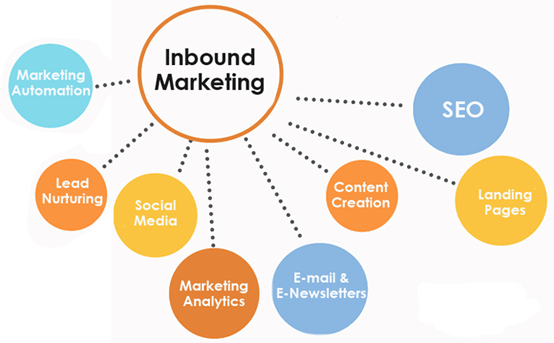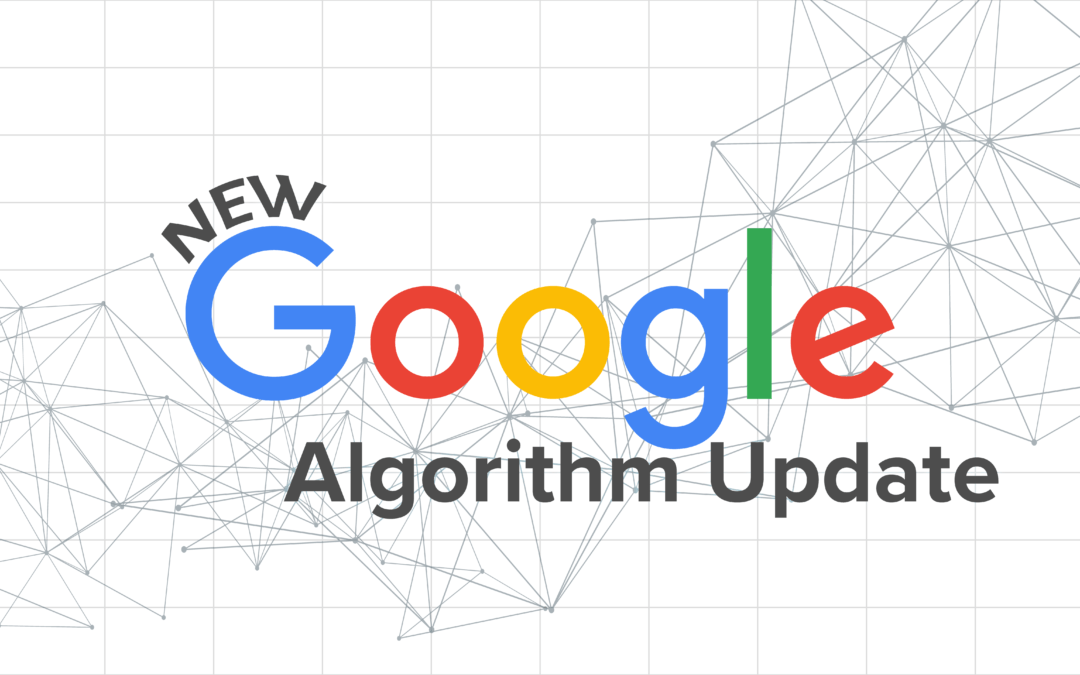Most small businesses don't have the time, budget, or resources to invest in traditional outbound marketing strategies such as television, radio, print ads, billboards, and direct mail. This leaves many business owners wondering how to get more leads through their websites.
That's where inbound marketing comes into play! It's a great strategy for any business, but it can be hard to get started and even harder to know what works best.
But, what is inbound marketing to begin with?
That’s precisely what you’ll learn in this guide. We'll break down the basics of inbound marketing, how it works, and what makes it effective so you can start leveraging it for your business.
Table of Contents
The Short Answer
Inbound marketing is a method of attracting, engaging, and delighting customers online through content with the help of search engine optimization (SEO), blogging, social media, and more.
It’s based on the idea that you can attract visitors to your website by producing valuable, relevant, and consistent content that pulls people toward your business.
By doing this, businesses can develop trust with their target audience, which leads to more sales opportunities down the line.
Inbound Marketing Versus Outbound Marketing
Since inbound marketing is the opposite of outbound, you may be wondering how it's any different.
Here are three key differences between the two.
Content vs. Advertising
First and foremost, inbound marketing isn't like traditional advertising that interrupts audiences with messages or promotions that they don't want. Instead, inbound marketing focuses on pulling people to your website through relevant content that they want to see.
Listening vs. Branding
Second, traditional advertising is mostly about branding as a marketing tool– that is, telling audiences who you are and what you stand for with the hope of making an impact on their perception of your company or product.
On the other hand, inbound marketing is about listening--that is, understanding your target audience through research and engaging with them on an emotional level.
Visibility vs. Conversions
Finally, traditional advertising (or outbound marketing) makes you visible to customers who may not be interested in what you have to offer at that time (or ever).
Conversely, inbound marketing efforts are all about –that is, targeting qualified leads and engaging with them in a way that turns them into loyal customers.
The Bottom Line
The main difference between inbound marketing and outbound marketing is that the former is all about consumers, while the latter is mostly about businesses.
With outbound marketing tools, marketers push their message to people who may or may not be interested in what's being advertised.
With inbound marketing, businesses attract consumers by producing relevant content that answers questions and provides value, leading to lifelong customer relationships.
Benefits of Inbound Marketing
Inbound marketing has been around for decades, and it's still going strong because it offers so many benefits to businesses and consumers alike. Here are the key ones.
Increases Quality Traffic to Your Website
It's simple: for lead generation, you need to have a website that people can find. By using inbound marketing strategies such as blogging, search engine optimization (SEO), PPC, and social media, you'll boost your rankings on search engines like Google so that you rank higher than your competitors for keywords related to your business.
How does that happen? By targeting the people you want to reach through content they actually care about. This is the best way to get your business in front of a larger audience.
This will result in more visitors to your website and, as a result, an increase in the number of leads and sales you get.
Builds Customer Trust
Inbound marketing helps build trust by demonstrating authority and expertise with every content piece you create.
If you can answer your target audience's questions with helpful, educational content that they want to watch, read, and share with others, you'll find that they're more likely to give you their business when it’s time.
That's because your business will be top of mind when your audience looks for solutions to their problems. And it's easier to purchase something from a company that you already know, like, and trust.
Boosts Brand Loyalty
Closely related to the previous point, with inbound marketing, your brand becomes part of your target audience's life rather than an interruption to it. In other words, you become an integral part of your target audience's day-to-day conversations and interactions.
This makes them more likely to become loyal customers because they'll feel personally invested in your brand. And once you have their business, they're unlikely to switch to your competitors.
Why? Because your target audience will have been exposed to your brand, product, or service on a more personal level. They'll be treated more like friends rather than strangers who are only interested in what you can do for them right now.
Cost-Effectiveness
While inbound marketing does cost money to engage in, it's less expensive than traditional outbound marketing strategies.
If you think about it, traditional marketing requires you to spend money on advertising, while inbound marketing work involves investing time to create helpful content that your target audience is actually looking for.
Plus, you're investing less money into people who may or may not care about your company. Well-targeted content that has been created with a specific buyer persona in mind is highly unlikely to be ignored.
Therefore, you'll get out more than what you put in because, when done well, the returns are greater with inbound efforts. That's why it can be a great investment.
Improves Search Engine Rankings
Inbound marketing plays a significant role in improving your search engine rankings because it helps you target those keywords that your potential customers are using to look for products or services.
So, as you develop content and publish articles, blog posts, videos, infographics, or any other helpful resource on the web – all of which is optimized – you're going to improve your search engine rankings.
And when you do, you'll have more traffic, which will lead to an increase in qualified leads and conversions to help grow your business.
Plus, search engines love fresh, quality content, so blogging will give Google a reason to rank your site higher than others.
More Conversions
Getting more traffic to your site is one thing. But it's not going to do you any good unless those people actually take an action that's beneficial for your business, right?
For example, if they visit your blog and browse through the articles but never sign up for your email list or make a purchase, this won't benefit you.
Well, don’t worry about that because by optimizing your content, you'll be able to convert users into leads and leads into new customers at a higher rate than traditional outbound marketing. And that’s all because you’re actually targeting qualified leads in the first place.
So if you're looking to scale up and grow your business, inbound marketing works!
Common Problems That Inbound Marketing Can Solve
So, now that you know the benefits of inbound marketing, what problems can it solve? Here are just a few.
Lack of Consistent Traffic
If your website is like everyone else's website and only gets traffic at random intervals, then you probably don't see any results. But since inbound marketing revolves around creating quality content for your target audiences, you'll get more consistent and relevant traffic.
In contrast, if you don't have a plan for content creation, you're unlikely to get traffic consistently. And if you can't bring people back time after time, then it’ll be challenging to build up your business the way you want to.
Therefore, inbound marketing puts an end to the lack of consistent traffic because it allows you to publish high-quality content over time that'll first attract your target audience and then engage them.
And because this content is evergreen (meaning it’ll remain relevant for an extended period), people will continue to visit your site regularly.
Poor Search Engine Rankings
If you're not ranked high in search engine results, you won't have traffic coming to your site. And if you can't capture that traffic, then there's no way you'll be able to achieve business growth.
With inbound marketing, namely through an SEO strategy, you'll be able to optimize your content through the use of keywords so you can attract your target audience and improve your site's visibility.
That way, more people will find you, and you'll receive more leads and sales. And, of course, you’ll rank higher on the SERPs!
Difficulties in Scaling Your Business
Building a successful business takes time, right? Well, the problem is that some people don't have all of that time because they need their business to grow more quickly.
That's where inbound marketing can be helpful again because it allows you to bring in leads and customers more efficiently than other forms of marketing.
So you're not just growing your business at a faster rate, but you're also spending less money to do it since inbound marketing is more cost-effective.
Obtaining Leads
You know that sinking feeling when your funnel is working, but the leads aren't there? That's only natural because it takes time for people to be exposed to your brand on social media or in their email inbox.
But since inbound marketing helps you gain exposure through various types of compelling content, you can get more leads in less time.
Establishing Authority and Credibility
All businesses know that they need to establish credibility and expertise in their particular field. That way, people can trust them and become more willing to buy from them.
Yet, of course, that’s easier said than done because it takes a lot of time and effort to achieve this type of authority.
Well, once again, inbound marketing can help you do all of that because it’ll allow you to publish content regularly to teach people about your industry and what you have to offer.
So not only will more people be exposed to your business, but they'll also be more inclined to trust you.
Using the Inbound Marketing Methodology
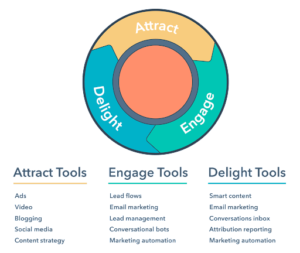
The inbound marketing methodology consists of three main strategies, all aiming to attract, engage, and delight customers. In fact, those are the names of the strategies, too.
Here's what they're all about.
Attracting Strategies
Just like its name implies, you want to attract your target audience by creating valuable content. You'll be doing things like blogging, producing videos, sharing useful infographics, and providing helpful e-books, case studies, or white papers to those who are searching for those types of resources online.
The purpose here is to deliver the content that your audience wants to consume, which will ultimately lead them to your site and attract them to your business at large.
To make this work, you’ll need to establish a content production schedule and a publishing schedule.
In short, create a content calendar and map out what resources you’re going to produce and when each piece of content will be published.
Here are a few tips to create content that attracts customers:
- Produce Content People Want: Publishing blog posts that provide valuable information is an important part of attracting your target audience. Think like your customers to excel at this.
- Publish Regularly: You'll definitely want to publish new content on a regular basis so that you can attract your target market.
- Produce Evergreen Content: Try to create resources, like e-books or whitepapers focused on education instead of trying to sell your products and services.
Engaging Strategies
Following the success of your attracting strategies, the different types of content you create will lead to increased traffic, which is exactly what you want!
So, the goal here is to engage with this targeted audience by encouraging them to take one action or another – like signing up for your email list, visiting your blog or social media profiles, filling out a contact form, opting for a free trial, and similar.
To get engagement off the ground, you're going to need to keep in touch with prospects and leads while they visit your site. That way, when it comes time for them to make a purchase or take another action that's beneficial for your business, they’ll think of you.
Moreover, you'll need to utilize different strategies like blogging (for content marketing), monitoring your brand's social accounts (to provide responses and converse with followers), and email marketing (so that you can send special offers or newsletters to subscribers).
Here are a few things to keep in mind when it comes to engaging with your audience:
- Encourage Interaction: Provide incentives that encourage your audience members to generate content (commenting) and share your resources (liking, tweeting, and more.)
- Sell Solutions, Not Products: Instead of solely focusing on selling your products and services, you'll want to provide resources that demonstrate how your audience's lives will improve if they take advantage of what you have to offer.
- Keep in Touch With Prospects and Leads: You’ll want to stay in touch with your leads and prospects throughout their journey so that you can plan out an effective nurturing sequence. Email campaigns are among the best ways to do that.
- Offer Exclusive Deals: Email subscribers about special offers or coupons so that they return to your site and eventually convert.
- Focus on Customer Service: Take care of how your customers feel when interacting with your business by providing stellar customer service.
Delighting Strategies
The final step in the inbound methodology is to use various strategies to delight and provide value to your leads and customers after they've already made a purchase or taken other actions.
Simply, the goal of delighting strategies is to provide your customers with an experience that makes them want to come back for more (or refer others to your business).
You want them to become loyal brand advocates, continue doing business with you, and recommend you to their family and friends.
To do this, you’ll need to focus on any issues that your customers may have by having a customer service team in place.
You'll also have to think deeply about how you can go the extra mile to delight your customers so that they'll want to keep doing business with you for the long term. Here are some ideas:
- Provide Resource-Rich Experiences: Think about what kinds of more resources can provide real value to your customers beyond what you're offering them now. You'll definitely want to provide those as part of your delighting strategies.
- Request Feedback: Ask your customers for feedback on their experiences throughout the customer life cycle and leverage that insight as an opportunity to delight them.
- Solve Customer Problems: Look for ways to integrate useful marketing automation tools and resources into your website that'll solve the problems your customers face.
- Offer Exclusive Deals: When customers feel like they're getting something valuable (or know that not everyone can get the same deal), they'll be more likely to return for more. Make sure that the deals you provide are actually valuable so that people want to come back for more, though.
- Focus on Social Media Listening: Use a social media listening tool to track what people are saying about your brand, offering, and industry. Then, you'll have the opportunity to take action on that feedback.
The Five Fundamentals of Inbound Marketing
According to HubSpot, the marketing automation platform, every inbound marketer should follow five fundamentals of inbound marketing to achieve success.
Namely, they're contacts, buyer personas, the buyer's journey, content, and goals.
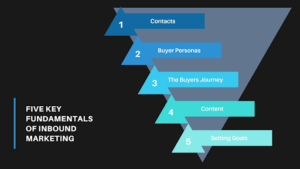
Here’s what they are and how each one can help you plan out a successful inbound marketing strategy.
1. Contacts
A contact is a person with whom a company has relationships – either in real life or in digital space. A contact could be a customer, prospect, employee, or even just an interested party.
Contacts are the foundation of any business, and they'll be your starting point for any inbound campaign that you create.
Remember to capture contacts in person, over the phone, and through the exchange of content either online or offline.
More importantly, you'll want to keep track of each of your leads so that they don't get lost in the shuffle and you don't lose them as a pipeline of new business.
For that, it's a wise idea to invest in a CRM (or customer relationship management) tool. You'll be able to organize, track, and measure contacts through their interactions with your brand.
2. Buyer Personas
According to HubSpot, buyer personas are “a semi-fictional representation of an ideal customer based on real data and educated speculation about demographics, behaviors, motivations, and goals.”
To simplify, personas are the unique fictional profiles that describe your ideal customers, and they’re based on data and insights collected through research and information gathered from past customers.
This means knowing their demographics, what they're interested in, where they live, how old they are, and more. You can also think about the persona of your ideal customer by including personality traits.
You'll further want to think about what kind of questions they might have, what their challenges are that they'd need help with solving, how you'd be able to assist them throughout the buying journey, and which pain points they might have that could be met with solutions from your business.
Create personas for every major segment of your customer base so that you can tailor your inbound marketing strategies to their specific needs.
For instance, this will allow you to generate content for your target personas so that they can see themselves reflected in your messaging.
This, in turn, will increase their engagement with your brand because of the emotional connection that they'll feel.
3. The Buyer’s Journey
The buyer's journey outlines the entire process that each of your customers goes through before purchasing something from you or becoming loyal advocates for your brand.
There are three main stages of the buyer's journey or sales process:
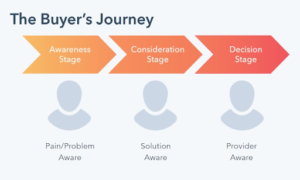
- Awareness Stage - During this stage, a prospect is in the early stages of researching their problem. They're looking for information online to see how other people have addressed it before. In other words, they're looking for content to help them solve their pain points or find solutions.
- Consideration Stage - As prospects are researching, they might start considering potential solutions to their problem. This will lead them down the path of making comparisons between you and your competitors. They'll want to learn more about different options that are available to them.
- Decision Stage - Finally, prospects will start moving towards making the final decision on whether or not they want to buy your product/service.
Remember that prospects might not go through each stage in this exact sequence. Buyers’ journeys can be very fluid, so you should consider it more as a general guide rather than something carved in stone.
Yet, keeping this framework in mind, it's easier to plan out your inbound strategy based on these different stages. You'll need different types of content for when they're in each stage of the process.
For instance, you'll want to create awareness content for the awareness phase so that people will be introduced to your brand before they even think about making a purchase. This could include producing useful industry-related content that helps people to learn about your topic while subtly promoting your brand at the same time.
You'll also want to ensure that you're capturing the right data while your prospects are in the consideration phase so that you can continue nurturing them with targeted content after they've become a lead.
4. Content
Inbound marketing relies on content in a few different ways. First of all, creating valuable content for your personas so that they can find it when they're searching online is key.
Your content has to be helpful for people and speak directly to their needs if you want them to look at your brand instead of just clicking past.
In addition to creating content for people, you can also use it to attract potential buyers. People are more likely to interact with your business when they know what kinds of information you're going through on a regular basis.
This is why it's important to share blog posts and social media updates based on the buyer’s journey discussed above.
Finally, you'll need content that helps to convert prospects into customers. Let's say that you've got a great webinar or white paper that'll really help people in the consideration phase of their buying process. You can use this content to get more people on your email list so that you can continue providing them with value and converting them into customers.
As you develop the content, it's important to remember SEO rankings. You want to rank higher in search engines and establish yourself as a thought leader within your industry. For that, focus on pillar pages and topic clusters.
Pillar pages are high-level blog posts that cover a specific topic thoroughly. You'll be able to rank with this type of content for a long time because it provides people with straightforward answers to their questions.
In contrast, topic clusters focus on different aspects of your main pillar topic. This is helpful because people often have a wide variety of questions that they're looking to answer. Instead of providing them with one or two answers, you can use topic clusters to give them a few different blog posts covering their needs.
Finally, you'll also want to make sure that it's easy for people to share and spread the word about your content online. This is especially important if you're using social media channels like Twitter, LinkedIn, and Facebook to distribute updates on your blog posts. Another great idea for your business is to request reviews from your customers.
Why Is Social Media an Important Part of Inbound Marketing?
Speaking of social media, social networks are an integral part of inbound marketing because they can help you to reach people who might not have otherwise found your website and have a pretty wide audience. So, it helps with brand awareness and might potentially give you access to new audiences.
For instance, Facebook has over 2.89 billion active users each month. If you're not using it to share your content, then you're missing out on a huge opportunity to get in front of new people who fit into one or more of your buyer personas.
Accordingly, it's important to have a social media presence that gets people excited about your upcoming content. You can do this by using images, videos, GIFs, and other types of social media posts that are eye-catching.
Then, you'll want to schedule the actual content ahead of time to ensure that it’s published at the best times for engagement with your social media followers.
Of course, it doesn't end there because you'll also want to use each platform's analytics tool so that you can track the traffic that your updates are driving back to your website. This will help you determine what types of social media content are most effective at increasing your inbound marketing performance.
In Conclusion
Inbound marketing is a customer-focused strategy that helps to bring people into your sales funnel. What makes inbound marketing efforts effective is that they take into consideration the buyer's journey and create valuable content that matches each stage of the journey.
You can also use social media marketing channels to broaden your reach and drive more people back to your website so that they can learn more about your business. Just remember SEO, pillar pages, topic clusters, and analytics so that you can consistently improve inbound marketing performance.
Now that you know what inbound marketing is and how to use it, feel free to reach out to us with any questions that you might have or for a website audit. We're always happy to help our clients launch a successful inbound marketing campaign, so let's get the conversation started today!
